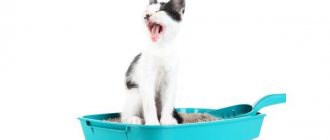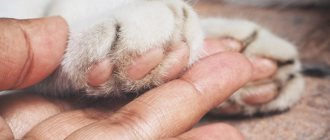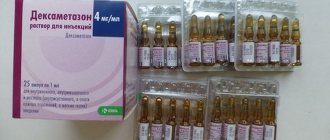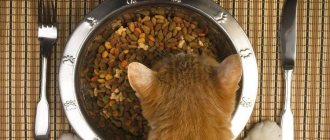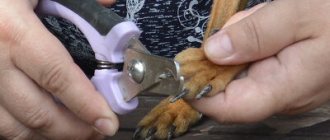Glucose for cats is prescribed in the treatment of various diseases and intoxication syndrome. It helps to support the weakened body of the animal during the period of illness and until complete recovery. When using the drug, it is important to follow the instructions for use from the manufacturer, which are included in each package, in order to maximally protect your pet from unwanted reactions. Glucose is usually given by injection. The procedure can be performed either by a veterinarian or the cat's owner at home.
Doing the injection correctly
Before injecting a cat with glucose subcutaneously, it is necessary to calm the animal, relax it and prevent it from becoming nervous. After this, you should carry out the procedure following the instructions:
- Secure the cat. The animal can be positioned in a way that is convenient for the owner for the procedure.
- With your left hand (for left-handers - right) take the animal by the withers and lightly squeeze it.
- Holding the cat with your elbow, slightly pull back the skin of the withers.
- With your right hand (for left-handers - your left), take a syringe with medicine and insert its needle parallel to the surface on which the animal is standing. The needle should not be more than a third under the skin. All movements should be made as smooth and confident as possible.
- Loosen your grip on your pet's withers and slowly release the glucose. Check that the drug is accurately delivered subcutaneously: if the cat’s fur does not become wet, then everything has been done correctly. Otherwise, the procedure must be repeated.
Any injections, including injections of glucose solution, can only be done as prescribed by a doctor!
Every owner should know that only a 5% glucose solution can be injected subcutaneously into cats. High concentrations can cause enormous harm to the health of the animal, including tissue necrosis.
Glucose is injected subcutaneously into the cat's withers, where the animal feels almost no pain.
Price
The solution is a fairly inexpensive drug. Its price will depend on the volume of the bottle, the concentration of the active substance, and the financial policy of the manufacturer.
On average, the cost for a 100 ml bottle is 50 rubles.
Home » Diseases » Glucose for animals instructions for use. Glucose for cats dosage
In the section on the question Question for veterinarians and knowledgeable people. What physical the solution is more nutritious than glucose (subcutaneously for a cat). asked by the author Outgrowth, the best answer is Subcutaneous injections with a nutrient solution for dehydration of the bodyLeonid Filippov For subcutaneous feeding with saline solution (or better Ringer-Locke solution from a human pharmacy), draw 10 cubes of saline solution into a 20-cc syringe.
There is also a 2% solution of Glucose in saline (also sold in human pharmacies) 2 cubes. If the cat is still dying of hunger, exhausted, then you can add five cubes of Glucose in saline a couple of times, nothing. In the same syringe - ONE type of vitamins. If it is an enteroinfection or the like, the most important vitamin is to alternate between B12, B6 and ascorbic acid.
The dose of vitamins is a quarter of a one-cubic ampoule. If you inject B12 (200 IU per ampoule), then take half an ampoule. If B12 (500 IU per ampoule) is a quarter of the ampoule. And it’s good to add cocarboxylase as the fourth component. I repeat, for each injection - one vitamin. Having collected all this into a syringe, chat, close the needle tightly with a cap and heat the syringe under running warm water until approximately 40 oC.
Then wipe and replace the needle with a needle from an insulin syringe. Using three fingers (thumb, index and middle) of the left hand, pull the cat’s skin so that the index finger is between her shoulder blades. A sort of hump-hood is formed with a fold under the index finger. Wipe thoroughly with alcohol.
Make sure that there is free space under the skin (as if there is air in it), press slightly on the syringe plunger so that the medicine splashes out just a little. Insert the needle into this space - be sure to make sure that its tip is UNDER the skin, and not IN skin. Inject the medicine (all 12-18 cubes) in a row - slowly - into this subcutaneous space.
It should be EASY to walk, as if in the air. If it doesn’t go, then the needle is in the skin! A soft swelling will form on the back of the neck for a short time - this is normal and completely painless for the cat. It will dissolve before our eyes, and the animal will immediately feel a little better. If the cat does not drink for a day or more, it should be injected once every three to four hours until the cat begins to pee profusely.
Properties of the drug
How does 5% glucose work? The instructions state that this remedy takes part in the metabolism in the body, and also enhances reductive and oxidative processes, improves the antitoxic functioning of the liver and increases the contractile activity of the heart.
It should also be said that the infusion of such a solution partially compensates for the H2O deficiency. Entering the tissues of the body, dextrose is phosphorylated and converted into glucose-six-phosphate, which is included in the main metabolic components of the human body.
Features of the medicine
What is remarkable about 5 percent glucose? The instructions say it has metabolic and detoxifying effects, and also represents an essential source of easily digestible and valuable nutrients.
During the metabolism of dextrose in tissues, a huge amount of energy is produced, which is essential for the normal functioning of the body.
The solution in question is isotonic. Its energy value is 200 kcal/l, and its approximate osmolarity is 278 mOsm/l.
Why is Glucose useful?
Glucose is widely used for the treatment of various pathologies, as it has a good effect on metabolic processes.
Pregnant women are prescribed glucose:
- If you suspect that the intrauterine fetus is smaller than the required size
- To reduce the chance of miscarriage
- To prevent premature birth
After consuming glucose, you feel better and fatigue goes away.
During pregnancy and lactation, it is necessary to constantly monitor plasma sugar levels.
Contraindications and possible adverse reactions in animals
Glucose is one of the components of the internal environment of the body, therefore it does not cause allergic reactions and does not require any adaptation. Once in the blood, it is partially transported to the tissues, and its excess, with the participation of the pancreatic hormone insulin, is converted into glycogen and stored as a strategic reserve. The endocrine system strictly controls that the level of glucose in the blood is in balance and does not go beyond normal limits.
If a cat has diabetes, then this process is disrupted, and the glucose solution introduced into the body can lead to a serious pathological condition - hyperglycemia. This means that if you have diabetes, you cannot give glucose injections at home.
It is also contraindicated to inject glucose if there are infectious processes, fungal infections, or pustules on the animal’s skin. In these conditions, there is a danger that the needle will penetrate the infection into the deeper layers of tissue, so it is recommended to refrain from any injections at home and entrust this manipulation to an experienced veterinarian.
You should also remember about complications associated with non-compliance with instructions and incorrect injection technique. These include inflammation at the injection site and needle breakage during the procedure. This usually happens when the cat is not properly restrained. In these life-threatening situations, you need to urgently contact a veterinarian for help.
When to use Glucose solution 5%
Toxic infections, infectious diseases, various intoxications (poisoning with hydrocyanic acid and its salts, carbon monoxide, aniline, arsenous hydrogen and other substances), liver diseases (hepatitis, cirrhosis, liver dystrophy and atrophy), cardiac decompensation, pulmonary edema, hemorrhagic diathesis and many other pathological conditions.
In ruminants it is prescribed for gastrointestinal diseases with symptoms of intoxication, hypotension, atony of the proventriculus, as well as for acetonemia, postpartum hemoglobinuria, ketonuria and toxemia. Glucose solutions are prescribed to weak and emaciated animals as an energy and dietary supplement.
The medicinal power of droppers
For infusion (intravenous), a 5% dextrose solution is usually used. The healing liquid is packaged in plastic, hermetically sealed bags or 400 ml bottles. The infusion solution consists of:
- Purified water.
- Directly glucose.
- Active excipient.
When dextrose enters the bloodstream, it breaks down into water and carbon dioxide, actively producing energy. The subsequent pharmacology depends on the nature of the additional drugs used that are part of the droppers.
Where is glucose used?
Why do they put in a glucose drip?
The purpose of such therapeutic treatment is carried out for many different diseases and further rehabilitation of an organism weakened by pathology. A glucose dropper is especially beneficial for health, for which it is prescribed in the following cases:
- hepatitis;
- pulmonary edema;
- dehydration;
- diabetes;
- liver pathologies;
- state of shock;
- hemorrhagic diathesis;
- internal bleeding;
- alcohol intoxication;
- general exhaustion of the body;
- a sharp decrease in blood pressure (collapse);
- profuse, persistent vomiting;
- infectious diseases;
- relapse of heart failure;
- accumulation of fluid in the pulmonary organs;
- stomach upset (prolonged diarrhea);
- exacerbation of hypoglycemia, in which there is a drop in blood sugar to a critical level.
Also, intravenous infusion of dextrose is indicated if it is necessary to introduce certain medications into the body. In particular, cardiac glycosides.
Indications for use: in what cases does it help?
Administration of glucose intravenously or subcutaneously, as well as feeding the cat with glucose, is required when prescribed by a veterinarian. It is recommended to give the drug to an animal in order to maintain strength in the body during illness. Administering the solution intramuscularly or intravenously is indicated in the following cases:
- severe intoxication associated with food poisoning and chemicals;
- dehydration of the cat's body;
- internal bleeding;
- state of shock;
- infectious diseases;
- liver dysfunction;
- diseases of the digestive system.
Return to contents
Prohibitions to introduce
In what cases should patients not be prescribed 5% glucose? The instructions (for cats this remedy should only be recommended by an experienced veterinarian) speaks of such contraindications as:
- decompensated diabetes mellitus;
- hyperglycemia;
- decreased glucose tolerance (including during metabolic stress);
- hyperlactic acidemia.
Glucose is prescribed with caution for decompensated chronic heart failure, hyponatremia, chronic renal failure (with oliguria and anuria).
How to reduce pain from an injection for a cat
To carry out the procedure correctly and as painlessly as possible for the cat, you need to accurately select the place where the injection will be given. Thus, for adults and large animals, glucose is most often prescribed to be injected into the withers, and small kittens are allowed to receive an injection into the upper part of the hind leg. Thus, the pet will feel less discomfort.
Also, a cat’s individual pain threshold may be too low, causing the animal to feel pain, resist and scream. For such pets, it is recommended that the procedure be carried out by a veterinarian who knows exactly where the injections should be given to reduce the cat’s pain.
The painfulness of the procedure for the animal may also depend on how many times and in what quantity glucose is administered. The less glucose is injected, and the fewer procedures are performed, the less pain the cat will feel.
Glucose 5% solution instructions for use
GLUCOSE SOLUTION 5% (Solutio Glucosi 5%)
COMPOSITION AND FORM OF RELEASE Glucose solution 5% – isotonic. Solutions of 10%, 25% and 40% are hypertonic. They are a clear, colorless or slightly yellowish liquid with a sweet taste, pH 3.0-4.0. Packaged in glass bottles of 100 ml, 200 ml, 400 ml and 500 ml.
PHARMACOLOGICAL PROPERTIES Glucose is one of the most easily digestible sugars. It is well absorbed into the blood, and its excess goes to the liver and muscles, where it is converted into glycogen. In the body, it breaks down to form energy, which provides heat and the work of muscles and other tissues. Glucose also stimulates the synthesis of hormones and enzymes in the body of animals and increases the body's defenses.
We suggest you familiarize yourself with Colds in cats: causes, symptoms and treatment
With intravenous administration of a hypertonic glucose solution, the osmotic pressure of the blood increases, the flow of fluid from tissues into the blood increases, metabolic processes increase, the detoxification function of the liver improves, the contractile activity of the heart muscle increases, blood vessels dilate, and diuresis increases.
INDICATIONS Toxic infections, infectious diseases, various intoxications (poisoning with drugs, hydrocyanic acid and its salts, carbon monoxide, aniline, arsenous hydrogen and other substances), liver diseases (hepatitis, cirrhosis, liver dystrophy and atrophy), cardiac decompensation, pulmonary edema, hemorrhagic diathesis and many other pathological conditions.
In ruminants it is prescribed for gastrointestinal diseases with symptoms of intoxication, hypotension, atony of the proventriculus, as well as for acetonemia, postpartum hemoglobinuria, ketonuria and toxemia. Glucose solutions are prescribed to weak and emaciated animals as an energy and dietary supplement.
DOSES AND METHOD OF ADMINISTRATION Depending on the severity of the disease, the drug is administered to animals orally or intravenously 1-2 times a day in the following doses (in ml per animal): Type of animal 5% glucose solution 10% glucose solution 25% glucose solution 40% solution -p glucoseCattle600 – 3000300 – 1500100 – 60075 – 370Horses600 – 2400300 – 1200100 – 50075 – 300Sheep, goats100 – 60060 – 30025 – 12010 – 75Pigs200 – 60 0100 – 30050 – 12020 – 75Dogs50 – 50020 – 25010 – 1005 – 50Isotonic (5% ) glucose solution is administered subcutaneously and intravenously. The dose volume and timing of application depend on the weight of the animal and the course of the disease.
SIDE EFFECTS With proper use and dosage, side effects are usually not observed.
CONTRAINDICATIONSHyperglycemia.
SPECIAL INSTRUCTIONS Animal products after using glucose solution can be used without any restrictions.
STORAGE CONDITIONS: in a dry place, protected from light, at a temperature of 0 to 25 °C. Shelf life – 2 years.
For dogs and other pets, this drug is prescribed on an individual basis, strictly according to indications. The same goes for people.
We suggest you familiarize yourself with How many times to feed chickens with compound feed
An isotonic dextrose solution should be injected into a vein at a maximum rate of 150 drops per minute. The recommended dosage for adult patients is 500-3000 ml per day.
For infants weighing up to 10 kg, this medication is prescribed at 100 ml/kg per day. It is not recommended to exceed the indicated dosages.
Forms of release of the drug
Dextrose is produced by the pharmaceutical industry in two forms. Both forms of solution are useful for people with weakened bodies, but have their own nuances in use.
This type of dextrose is intended to restore the functioning of weakened internal organs, as well as to replenish lost fluid reserves. This 5% solution is a powerful source of nutrients essential for human life.
What is isotonic glucose solution
An isotonic solution is administered in different ways:
- Subcutaneously. The daily volume of administered medication in this case is 300-500 ml.
- Intravenously. Doctors may prescribe the medication intravenously (300-400 ml per day).
- Enema. In this case, the total amount of administered solution is about 1.5-2 liters per day.
It is not recommended to administer glucose intramuscularly in its pure form. In this case, there is a high risk of developing purulent inflammation of the subcutaneous tissue. Intravenous injections are prescribed if a slow and gradual infusion of dextrose is not required.
This type of dextrose is necessary to improve the functioning of a damaged liver and resuscitate metabolic processes. Additionally, a hypertonic solution restores normal diuresis and promotes vasodilation. Also this dropper with glucose (10-40% solution):
- increases metabolic processes;
- improves myocardial functioning;
- increases the volume of urine produced;
- promotes dilation of blood vessels;
- increases the antitoxic functions of the liver organ;
- enhances the passage of fluid and tissue into the bloodstream;
- increases the osmotic pressure of the blood (this pressure ensures normal water exchange between body tissues).
Hypertonic solution is prescribed by doctors in the form of injections and droppers. When it comes to injections, dextrose is most often administered intravenously. It can also be used in combination with other medications. Many people, especially athletes, prefer to drink glucose.
What are hypertonic solutions
The hypertonic solution, administered by injection, is diluted with thiamine, ascorbic acid or insulin. A single dose in this case is about 25-50 ml.
How to draw the drug into a syringe
1. GENERAL INFORMATION
Avoid skipping the next dose of the drug, as this may lead to a decrease in its therapeutic effectiveness. If one dose is missed, the use of the drug is resumed as soon as possible in the same dosage and according to the same regimen.
When using Glucose 5% and 40% in accordance with these instructions, no side effects or complications are observed in animals. The use of glucose solution does not exclude the use of other medications. Animal products are used during and after the use of the drug without restrictions.
IV. Personal preventive measures When carrying out therapeutic and preventive measures using Glucose, you should follow the general rules of personal hygiene and safety precautions provided for when working with medicines. While working with the drug, do not drink, smoke or eat.
At the end of work, hands should be washed with warm water and soap. People with hypersensitivity to the components of the drug should avoid direct contact with the solution. If the drug accidentally comes into contact with the skin or mucous membranes, they must be washed with running water and soap. If allergic reactions occur or if the drug accidentally enters the human body, you should immediately contact a medical facility (bring with you the instructions for use of the drug or the label).
Empty drug bottles must not be used for household purposes; they must be disposed of with household waste.
Organization-, Russia, 394087, Voronezh region, Voronezh, st. Lomonosova, 114-b.
With the approval of this instruction, the instructions for the use of Glucose 5% and 40% solution for injection, approved by Rosselkhoznadzor on May 22, 2008, become invalid.
Although glucose does not cause contraindications and there have been no cases of overdose in cats, it is important to follow the instructions, and then the pet will recover and gain strength.
Vet
Special Information
In veterinary practice, the use of isotonic glucose solution is in great demand. This drug is actively used to replenish the body of animals with fluid and nutrients.
As a rule, this drug is prescribed to cats, dogs, sheep and other animals with significant fluid loss, intoxication, shock, poisoning, liver disease, hypotension, gastrointestinal diseases, atony, acetonemia, gangrene, cardiac decompensation, hemoglobinuria and other conditions .
For exhausted and weak animals, the solution in question is prescribed as an energy drug.
Contraindications
Glucosi is used as an auxiliary drug, which is aimed at maintaining the strength of the animal’s body during illness. It can also be used to dilute other medications.
The most common reasons for use in cats are:
- severe intoxication (food poisoning, chemical poisoning, inflammatory diseases, etc.);
- replenishment of fluid loss;
- bleeding;
- shock phenomena;
- infectious diseases;
- liver dysfunction;
- pathologies and diseases of the digestive system.
Important! The dosage of glucose for cats and the duration of use should be strictly prescribed by the treating veterinarian. Do-it-yourself activities can harm your pet’s health!
The solution is not used in animals that have individual intolerance to the components of the drug or diabetes mellitus.
Despite the fact that no overdose symptoms have been recorded in animals, you should not exceed the dose of the drug indicated by your doctor.
Owner reviews
“The cat was diagnosed with acute gastroenteritis. They prescribed a course of certain medications and glucose. Basic medications were administered directly from the vet, and at home I injected my own glucose. The cat’s illness did not linger; she gradually began to eat and drink on her own, after which the medications were discontinued. The question arose when the solution for veterinary purposes ran out and I had to buy a regular (human) one. It turns out that it can also be injected into animals, but it is advisable to still use a veterinary one.”
“A kitten strayed to us and we decided to keep it. However, he turned out to be sick, did not eat, did not drink, was lethargic, vomited, and lay motionless. They took him to the veterinarian, where they took blood tests - it turned out to be a bacterial infection. An antibiotic and glucose injections were prescribed. Getting the kitten out turned out to be difficult, but we did it. Glucose helped very well to support the animal, since he could not eat anything and even vomited from water. Now everything is all right".
Preparation for the procedure
The first and main point of preparation for the injection procedure should be a visit to the veterinarian with your pet. Most often, glucose is prescribed to rid the cat of the following diseases and abnormalities:
- Loss of fluid from the animal's body;
- The phenomenon of shock;
- Intoxication of the cat's body;
- Liver diseases;
- Diseases of the digestive system;
- Weakness and lethargy of the pet.
In this case, the injections may not contain an exclusive glucose solution, but a mixture with other drugs and antibiotics prescribed by the doctor.
Before you begin the injection procedure at home, you need to prepare all the necessary materials:
- Glucose solution in a closed container with a rubber stopper - 200 or 400 ml;
- Disposable syringe, preferably imported;
- Clean water for diluting the drug;
- Other drugs - when prescribed together with glucose.
Operating principle
In veterinary medicine, isotonic and hypertonic glucose solutions are used. For cats, one of these types may be used depending on the condition of the animal.
The isotonic solution has a concentration of active substance of 5%. It is an easily digestible source of nutrition aimed at providing the animal’s body with the required energy. Glucose injection accelerates the removal of toxins, improves metabolism, and restores water balance.
A hypertonic solution contains 10, 25 and 40% of the main element. It plays an important role in improving the filtration properties of the liver and normalizes heart function. It has a beneficial effect on blood vessels and normalizes blood pressure. The drug helps to enhance the synthesis of hormones and enzymes in a weakened body, which increases its resistance to the disease.
Mode of application
The dose of glucose for cats is determined strictly individually. It is calculated depending on the weight of the animal, the concentration of the active substance, and the type of disease. The approximate dosage is:
- 5-50 ml for a 5 percent solution;
- 5-20 ml for 40 percent.
The drug is usually prescribed 2-4 times a day.
https://www.youtube.com/watch?v=ytadvertise
The drug can be administered subcutaneously or intravenously. A solution with a concentration of the active substance of 40% is administered only intravenously.
General characteristics
Glucose injection (Glucosi Solutio proinjectionibus) is a clear or pale yellow liquid that is placed in a glass vial or bottle. To ensure the tightness of the contents, a rubber stopper is used, which is reinforced with a metal cap. The bottle is accompanied by instructions from the manufacturer, which describe in detail its contents, method of use, expiration dates and GOSTs. The bottle with liquid is stored at above-zero temperatures up to 25C in a dark place, protected from excess moisture. Shelf life – 2 years.
The active ingredient of the drug is crystalline medical or hydrated glucose. Auxiliary elements are sodium chloride, water for injection.
They produce 5%, 10, 25 and 40% medicinal products, in which the active substance content is 5, 10, 25 and 40 g per 100 ml, respectively.
The market offers a wide variety of Russian and foreign-made drugs. The drug from the Voronezh pharmacological organization is quite popular. The developer produces an injection solution with different percentages of the active substance and varying volumes (from 10 to 500 ml). It can be used in the treatment of cats, dogs and other domestic animals, as well as large and small livestock.
Types of solutions used and the principle of their action
In veterinary practice, glucose solutions with unequal concentrations are used. The use of hypertonic solutions (10, 25 and 40%) is limited exclusively to intravenous administration. For subcutaneous administration, use a 5% hypotonic glucose solution. The number 5 means that 100 ml of solution contains 5 g of glucose.
With the subcutaneous route of administration, the body is enriched not only with the drug itself, but also with water, which plays the role of a solvent. Additional fluid benefits symptoms of dehydration by replenishing the lack of fluid in the tissues. However, in case of edema and impaired kidney function, excess fluid can cause a worsening of the condition. In the absence of contraindications, the course of subcutaneous injections ranges from 5 to 10 days.
Symptoms
Symptoms of hypoglycemia vary depending on the specific form of the disease. In the normal course of the disease, the following signs indicate hypoglycemia:
- increased secretion of saliva;
- lethargy, apathy, drowsiness;
- sudden loss of appetite for no obvious reason;
- inactivity;
- digestive disorders;
- chills.
Acute hypoglycemia is characterized by the presence of the following symptoms:
- loss of consciousness;
- severe cramps;
- coma (in the most severe cases);
- paralysis.
Dog owners should be aware that although an episode of acute hypoglycemia can be very frightening, it can be controlled with fairly simple measures. To do this, you need to give the dog an injection of glucose or give the dog a drink of water in which sugar is dissolved in large quantities. If the dog actively resists, you should try to open its mouth and forcefully pour water into it. But caution is necessary, since in this case there is a risk that the animal will choke.
Rules for feeding a cat after poisoning
In the first two to three days of illness, the food should be liquid or pureed. Give it in small portions, focusing on the cat’s appetite. You should not give your animal dry food, as solid particles will injure the mucous membrane of the digestive tract.
There is no need to feed the cat immediately after vomiting, as this may provoke a new attack . Give water and any drink after an attack with caution. Food is prepared several times a day, for 1 - 2 feedings. The food offered should be slightly warmed or at room temperature. Do not give your cat cold or hot food.
How should a cat's diet be structured after poisoning? The diet is followed for 1 – 2 weeks. Then, depending on the severity of intoxication and the pet’s well-being, the pet is transferred to a regular diet or medicated food.
First day
A fasting diet is recommended for 24 hours after the first attacks of vomiting and diarrhea.
For kittens, the duration of the fast is 12 hours. This is necessary to relieve the liver and pancreas, which are the first to suffer in case of poisoning. Digestion of food is a process that requires intense work of all organs. Therefore, a fasting diet gives the body time to cope with the first onslaught of toxins. During this period, the animal is given only water and oral rehydration solutions to drink. To remove residual poison from the gastrointestinal tract, the veterinarian may prescribe intestinal enterosorbents, gastric lavage, and a cleansing enema.


